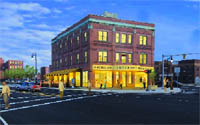
Landmark Decisions
AIC Becomes Preferred Developer for Mason Square Revitalization Effort

An architects rendering of the potential re-use of the Mason Square fire house.
Springfield Mayor Domenic Sarno calls the architects rendering of the proposed redevelopment of the Mason Square fire station and adjoining structures stunning.
And hes right.
Drafted by Centerbrook Architects in Centerbrook, Conn., the rendering depicts the fire station, vacant since the mid-80s, as a center of activity and commerce. It lights up the whole area, Sarno said of the facility in the image, which will feature a cyber café; the American International College radio station, WAIC; and other campus facilities. That fire station could become the iconic building that epitomizes continued redevelopment of the State Street corridor.
Sarno, like other elected officials, knows its not wise to get carried away with slick renderings of redevelopment projects that may never materialize, but in this case, hes apparently done exactly that. And he chalks it up to his excitement with what could happen in Mason Square now that AIC has been granted whats known as preferred-developer status for a complex that includes the fire station and the adjacent former Indian Motocycle building.
The college now has 135 days to do some additional due diligence on the parcels in question and decide whether and perhaps how to proceed, said John Short, AICs vice president for Institutional Advancement, who acknowledged that it may be a while before anything remotely resembling whats depicted in the rendering becomes reality. But he told BusinessWest that this scene could become reality if that assessment period ends with positive reports and the college is confident it can acquire the funding for the initiative.
Theres a lot that we have to look at, and it could all come together, he said. Were trying to continue what Congressman Neal has done [the federal courthouse project and extensive streetscape work along the corridor] and what the city has done in terms of revitalizing the area. I think this would be a huge step; this could be very exciting.
The properties in question are known as Indian Motocycle A, Indian Motocycle B, and the Mason Square Fire Station, as designated in the request for proposals (RFP) issued late last fall. AICs was the only proposal submitted.
It calls for development of all three properties, meaning the undertaking of needed improvements to parcel A and bringing more housing units onto the market in the occupied portion of the former manufacturing complex; finding new uses for parcel B, which has some environmental issues; and brining new life to the long-dormant fire station.
MassHousing owns parcel A, while the city of Springfield controls B and the former fire station, said John Judge, chief economic development director for the city, adding that the two entities partnered in the RFP to present a larger, more-attractive development opportunity.
For AIC, the project represents an opportunity to expand and enhance its facilities, while also taking a lead role in revitalization efforts in Mason Square and the broader State Street corridor, said Short. Meanwhile, for the city, the project represents a chance to find a remedy for property that has been a source of continual frustration for nearly 30 years.
And if AIC does proceed as planned, it will represent only the latest example of how area colleges have become engines of economic development, as Sarno called them, in neighborhoods across the Valley.
Were playing to our strength, our colleges and universities, said the mayor, noting that several schools, from UMass Amherst to Westfield State College to Springfield Technical Community College and others, have played pivotal roles in efforts to revitalize neighborhoods and create jobs.
Sarno said that, early in his first term (he was elected in 2007), he saw first-hand the impact Trinity College had on revitalization efforts in Hartford through public-private partnerships, and committed himself to duplicating such efforts in Springfield.
UMass Amhersts plans to locate one of its departments in Court Square is an example of such redevelopment, he said, while AICs RFP submission could change the face of another neighborhood. And the real hope, expressed by all those involved, is that, if AICs proposal becomes reality, it spurs additional activity along the State Street corridor.
Plans are still quite preliminary, said Short, adding that they are likely to become more firm over the next few months.
Key elements of the proposal involve continuing the current mix of housing in parcel A (involving area residents and some overflow student housing) and bringing more units onto the market, especially market-rate units. In B, several options will be considered, said Judge, including more housing and perhaps incubator space that may complement existing startup space at STCC.
As for the fire station, plans for the cyber café are preliminary, said Short, citing the apparent need for such a facility on the campus and in the community. The schools radio station and other Communications Department programs could go on the second floor, while a host of options will be considered for the third, which features some dramatic views of of downtown Springfield and Mason Square.
Like parcel B, the fire station has some environmental issues, said Short, adding that, by the end of the due-diligence period, the school should know if they can be overcome.
Preliminary price tags are only guesstimates, Short continued, adding that the fire-station portion of the project alone could reach $4 million to $5 million.
The school will obviously need to tap into a number of funding sources to meet that cost and others associated with the project said Short, and finding those sources is part of the due-diligence process.
What people have to remember is that were a college; were a nonprofit. We dont have a lot of money, and were not a private real-estate developer, he told BusinessWest. One of the issues with parcel A has been companies coming in, taking large fees out on the front side of the deal, getting tax credits over a period of time, and then they stop taking care of the building; thats happened several times over the past 25 years.
Were not in that position, he continued, so we have to do this in partnership with the city and with the state, and find sources of money that make it economically feasible for the college to do.
In other words, no one can say with any certainty whether the architects rendering that has so intrigued the mayor will become reality, but its clear that it represents by far the best hope for the Mason Square area in some time.




